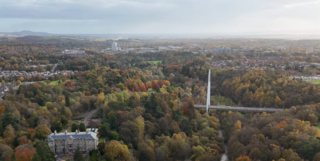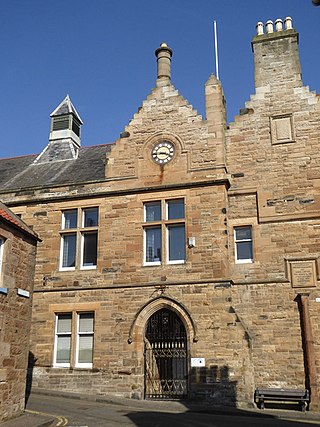
Fife is a council area, historic county, registration county and lieutenancy area of Scotland. It is situated between the Firth of Tay and the Firth of Forth, with inland boundaries with Perth and Kinross and Clackmannanshire. By custom it is widely held to have been one of the major Pictish kingdoms, known as Fib, and is still commonly known as the Kingdom of Fife within Scotland. A person from Fife is known as a Fifer. In older documents the county was very occasionally known by the anglicisation Fifeshire.

Sir David Wilkie was a Scottish painter, especially known for his genre scenes. He painted successfully in a wide variety of genres, including historical scenes, portraits, including formal royal ones, and scenes from his travels to Europe and the Middle East. His main base was in London, but he died and was buried at sea, off Gibraltar, returning from his first trip to the Middle East. He was sometimes known as the "people's painter".
Cupar is a town, former royal burgh and parish in Fife, Scotland. It lies between Dundee and Glenrothes. According to a 2011 population estimate, Cupar had a population around 9,000, making it the ninth-largest settlement in Fife, and the civil parish a population of 11,183. It is the historic county town of Fife, although the council now sits at Glenrothes.

Glenrothes is a town situated in the heart of Fife, in east-central Scotland. It had a population of 39,277 in the 2011 census, making it the third largest settlement in Fife and the 18th most populous locality in Scotland. Glenrothes is the administrative capital of Fife, containing the headquarters of both Fife Council and Police Scotland Fife Division and is a major service centre within the area.

Fife Scottish Omnibuses Ltd, is a bus operating company part of Stagecoach East Scotland based in Dunfermline, Scotland.

North East Fife is a county constituency in Fife, Scotland, represented in the House of Commons of the UK Parliament by Wendy Chamberlain of the Liberal Democrats since the 2019 general election.

Fife Constabulary was the territorial police force responsible for the Scottish council area of Fife.

Fife Council is the local authority for the Fife area of Scotland and is the third largest Scottish council by number of councillors, having 75 elected council members.

The Hopetoun Monument is a monument in the Garleton Hills, near Camptoun, East Lothian, Scotland. It is 95 feet (29 m) tall and is situated on Byres Hill near Haddington.

Mount Hill rises from the rolling farmland about three miles north west of Cupar in North East Fife, Scotland. On its summit stands the 29-metre (95 ft) high Hopetoun Monument, which is visible for many miles around.

The Chambers Institution is a municipal structure in the High Street in Peebles, Scotland. The structure, which was designed to accommodate a library, a museum, an art gallery and Peebles Burgh Hall, is a Category A listed building.

Charles Lees was a Scottish portrait painter who also specialised in sporting and recreational subjects.

The County Buildings are in the High Street, Linlithgow, Scotland. The complex, which was the headquarters of West Lothian County Council, is a Category B listed building.

Cupar Burgh Chambers is a municipal structure in St Catherine Street in Cupar, Fife, Scotland. The building, which was the meeting place of Cupar Burgh Council, is a Category B listed building.

Anstruther Town Hall is a municipal building in School Green, Anstruther Easter, Fife, Scotland. The structure, which is used as a community events venue, is a Category B listed building.

Cellardyke Town Hall is a municipal structure in Tolbooth Wynd, Cellardyke, Fife, Scotland. The building accommodates a local history museum and is also used as a local events venue. The mercat cross, which has been affixed to the front of the building, is a Category B listed structure.

Wick Town Hall is a municipal building in Bridge Street, Wick, in the Highland area of Scotland. The structure, which is used as a community events venue, is a Category B listed building.

Fife House, formerly Glenrothes House, is a large office development on North Street in Glenrothes, Fife, Scotland. It was built for Glenrothes Development Corporation in 1969, then became the headquarters of Fife Regional Council from shortly after its formation in 1975 and then became the offices and meeting place of Fife Council in 1996.



















